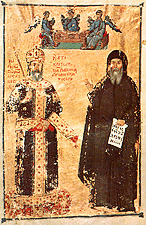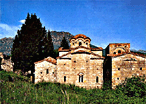 |
|
 |
The Kantakouzenoi
 he Kantakouzenoi, whose aristocratic lineage goes back to the end of the 11th
he Kantakouzenoi, whose aristocratic lineage goes back to the end of the 11th
 century, were one of the greatest land-owning families in the realm. The name Kantakouzenos is a compound one and probably comes from the words "kata-kouzenan" or "kata-kouzenon". Since Kouzenas was the name of a place near Smyrna, one may assume that the family had come from Asia Minor, where its original property lay. Towards the middle of the 14th century, the lands owned by the Kantakouzenoi extended around the town of Serres, in all of Thessaly as well as in Constantinople. century, were one of the greatest land-owning families in the realm. The name Kantakouzenos is a compound one and probably comes from the words "kata-kouzenan" or "kata-kouzenon". Since Kouzenas was the name of a place near Smyrna, one may assume that the family had come from Asia Minor, where its original property lay. Towards the middle of the 14th century, the lands owned by the Kantakouzenoi extended around the town of Serres, in all of Thessaly as well as in Constantinople.
Members of the family had already been active in the army since 1258, and many had earned titles and governed areas such as Epiros and the Peloponnese. Their important role in the political administration is proven by the active participation of
John VI Kantakouzenos
(1295-1383) in the class conflicts of the first half of the 14th century and finally in his occupation of the throne between 1347 and 1354.
 Although the Kantakouzenoi adhered to the principle of endogamy, it is worth mentioning that, for diplomatic reasons, members of the family were occasionally forced to marry outside the aristocratic circles of the capital. Such was the case, in 1346, when the daughter of John VI married the Ottoman prince
Orhan. Although the Kantakouzenoi adhered to the principle of endogamy, it is worth mentioning that, for diplomatic reasons, members of the family were occasionally forced to marry outside the aristocratic circles of the capital. Such was the case, in 1346, when the daughter of John VI married the Ottoman prince
Orhan.
Many Kantakouzenoi also became prominent patrons of the arts and letters. In 1365, for instance, the despotes
Manuel Kantakouzenos
founded the monastery of Christ Zoodotes in Mistra, which, according to research, can be identified with the church of Hagia Sophia. John VI also proved his faith in the ideal of monasticism and the esteem in which he held it, not only by his donations to the Vatopedi monastery on Mount Athos but also by his assuming the habit of a monk and retreating to this monastery himself in 1354/55. As an active participant in the intellectual life of the state, he fervently supported the spiritual movement of the Hesychasts, while, during his monastic years, (1354-1383) he occupied himself intensively with writing.
See also: Hesychasm
Mistra-Hagia Sophia
|